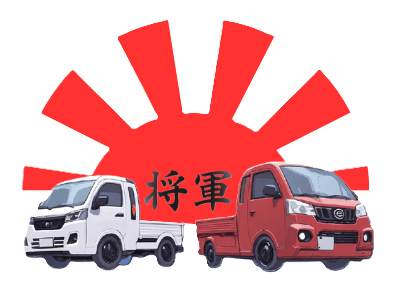The Suzuki Carry Review & Specs
The Suzuki Carry is a Kei truck from Suzuki, with a van version called the Every introduced in 1982. Both models belong to the “kei car” category. In this article, we will go over each generation from 1961 to the present.

First-Gen Suzuki Carry 1965–1969
The Carry series began in October 1961 with the debut of the FB Suzulight Carry, a compact pickup with a unique design and engine located under the front seat. In October 1963, the FB Carry was updated for the 1964 model year, and in September 1964, the stylish FBD Carry Van was introduced. All models were powered by a lively two-cylinder engine, delivering 21 horsepower, which evolved into a three-cylinder version used until late 1987. It has a maximum speed of 76 km/h (47 mph) and a durable leaf spring suspension.
- 359 cc FB two-stroke I2, 21 HP
- Front-Mid-Engine RWD
- Van Conversion
- 3-Speed Manual
- Top-Speed: 47 mph


Second-Gen Suzuki Carry 1965–1969
In June 1965, Suzuki launched the updated L20 Suzulight Carry, replacing the FB model. This version has improved handling and an innovative lubrication system, while the engine retained its 21 horsepower for efficient performance. By January 1966, the Carry Van evolved into the L20V, with the L21 pickup and the L20H pickup, which could seat four passengers. The new model has a cruising speed of 75 kilometers per hour and includes a convenient two-part tailgate with sliding windows. Production moved from Toyokawa in August 1967.
- 359 cc FB two-stroke I2, 21 HP
- Front-Mid-Engine RWD
- Van Conversion
- 3-Speed Manual
- Top-Speed: 47 mph

Third-Gen Suzuki Carry 1966–1969
The Suzuki Carry L30 features a sleek cover design. It was launched in February 1966. A fun version is the L30H. The L31 has a bed for more effortless loading while maintaining reliable performance. It is capable of carrying up to 350 kg (770 lbs). In March 1968, the Carry Van (L30V) debuted. It featured four doors and a two-part tailgate, all while preserving the classic body style.
- 359cc FB two-stroke I2, 21 hp
- Front-Mid-Engine RWD
- 3-Speed Manual
- Van Conversion


Forth-Gen Suzuki Carry 1969–1972
The L40 Carry, designed by Giorgetto Giugiaro, debuted in July 1969 and was followed by a van version in November. This innovative van featured two sliding side doors. This design made it symmetrical, but its limited interior space didn't appeal to traditional Japanese commercial customers.

The L40 is powered by the popular FB engine, with 24 HP—2,990 mm in length and 1,295 mm in width, featuring a 359 cc engine. The truck can handle 350 kg, and the van has 300 kg, reaching a top speed of 95 km/h (59 mph). In April 1971, the Carry received an upgraded FB engine producing 26.6 HP. The Panel Van had a boxy design on a sturdy chassis, and the V40FC camper was introduced that year. Production of the truck versions ended in May 1972, while the L40V van continued for three months before the L50 Van took its place.
- 359cc 24 HP- 596cc 26.6 HP
- Front-Mid-Engine RWD
- 3-Speed Manual
- Van Conversion

Fifth-Gen Suzuki Carry 1972–1976
The fifth-generation L50 Carry truck debuted in May 1972, followed by a Carry van in August. This design features rounded headlights for the truck and a sleek rectangular back with a sliding side door for the van. A reliable water-cooled engine producing 28 horsepower can carry a maximum load of 350 kg (about 770 lbs).

The release of the five-door van version, the L50VF, in December 1972 featured sliding side doors. Just three months later, the model (L51) was introduced. By November 1973, the Carry underwent a facelift, updated bumper, and a new dashboard design. In September 1975, a special export version was launched, introducing the L60 series with a larger 446 cc engine. Enhanced with a stronger differential and improved springs, it could carry up to 550 kg (about 1,210 lbs). However, the engine in L50 domestic models faced a slight power reduction to meet new emissions regulations.
- 359cc 24 HP- 446cc 28.6 HP
- Front Mid-Engine RWD
- 3-Speed Manual
- Van Conversion

Sixth-Gen Suzuki Carry 1976–1979
In May 1976, Suzuki launched the Carry 55, a kei car featuring a 539 cc water-cooled LJ50 engine, The ST11 model with a bed. By late 1977, the Carry 55 transitioned to the ST20, introduced in September 1976, the Suzuki Carry Wide 550, with more space but retaining the original design. The ST20 could carry up to 350 kg (772 lbs) and generate approximately 26 HP. In 1977, the export-only ST80 was released with a 797 cc engine from the LJ80 Jimny, producing 37 hp.
- 539 cc 30 HP / 797 cc 37 HP
- Front-Mid-Engine RWD
- 4-Speed Manual
- Van Conversion
- Wheelbase: 68.7 – 72.4 Inches
- Length: 119.5 -125.8 Inches
- Width: 51-54.9 Inches

Seventh-Gen Suzuki Carry 1979–1985
In March 1979, Suzuki unveiled the ST30 series of the Carry truck, which retained its classic size but featured a two-stroke engine under the front seat. The Carry had dominated Japan's Kei truck market, being a best-seller for eight consecutive years. The ST90 has a 797 cc four-stroke engine for international markets starting in August 1979. By October 1980, the Carry evolved into the ST40 with a 543 cc four-stroke engine, while some export variants had a more powerful 970 cc four-cylinder engine. In December 1982, the Carry van became the Suzuki Every, equipped with a four-stroke engine to meet new pollution standards. Additionally, in May 1981, Suzuki introduced a four-wheel drive option, first for the pickup and later for the van in November 1982. What a fantastic journey for the Carry!
- 539 cc 30 HP / 797 cc 37 HP
- Front-Mid-Engine RWD & 4WD
- 4-5 Speed Manual
- Van Conversion
- Wheelbase: 72 – 78 Inches
- Length: 125.8 -139 Inches
- Width: 51-54.9 Inches
- Weight: 1,290–1,731 lb

Eighth-Gen Suzuki Carry 1985–1991
In March 1985, Suzuki launched the eighth generation of the Suzuki Carry and the second generation of the Suzuki Every, featuring a more robust fuel-injected engine. Some models still use a two-stroke engine until a design revamp in July 1986. By late 1987, the Every introduced a turbocharged engine, while a supercharged was an option along with a limited-edition Every. In May 1989, Suzuki unveiled a new engine that replaced many earlier models.
- 539 cc 31 HP / 797 cc 47 HP
- Supercharger: 51.2 HP
- Front-Mid-Engine RWD & 4WD
- 4-5 Speed Manual
- Weight: 1,323–1,720 lb
- Wheelbase: 72
- Length: 129 -130 Inches
- Width: 55-58 Inches
- Van Conversion

Ninth-Gen Suzuki Carry 1991–1999
The Suzuki Carry's ninth generation and the Every's third generation debuted in September 1991. They introduced a 657 cc engine and a modern design with rectangular headlights. The Carry featured a longer wheelbase for improved stability, and the vans had an even longer wheelbase for better handling. In September 1993, the Carry was upgraded with disc brakes across all models. Production of the ninth generation continued until 1999. In late 1997, Suzuki introduced a retro-style model, the Suzuki Every C, combining nostalgia with modern appeal.
- 36–63 hp
- Front-Mid-Engine RWD & 4WD
- 4-5 Speed Manual & Auto
- Weight: 1,433–1,587 lb
- Wheelbase: 72
- Length: 130 Inches
- Width: 55 Inches
- Van Conversion



Tenth-Gen Suzuki Carry 1999–2013
In Japan, the van version was renamed “Every,” reflecting a new chapter. This generation continued with the F6A engine but included updates. DA/DB52 T for the truck and V for the van, with “DB” indicating four-wheel drive. Initially, all versions featured a turbocharged engine delivering 59 HP, which was discontinued in May 2000 but returned in September 2001 with the new K6A engine. In June 1999, the DA52W, a two-wheel-drive Every Wagon, launched with a larger Every Plus. By 2001, an upgraded Every with the K6A engine. In May 2002, and an updated door design in April 2009. The Every Van and Wagon continued production until August 2005.
- 50 – 59 hp
- Front-Mid-Engine RWD & 4WD
- 4-5 Speed Manual & Auto
- Weight: 1,433–1,720 lb
- Wheelbase: 75
- Length: 134 Inches
- Width: 58 Inches
- Van Conversion

Eleventh-Gen Suzuki Carry 2013-2024
Kei trucks showcase a unique charm, especially models like the Suzuki Carry and its extended version, the Super Carry. Recently, Suzuki launched an exciting special edition in Japan called the Super Carry X Limited. This compact truck features a rugged design with attention-grabbing sideline decals that mimic metal panels.
Under the hood, the Super Carry X Limited is powered by a 658 cc three-cylinder gasoline engine, delivering 50 horsepower, and a four-wheel-drive system with either a 5-speed manual or a 4-speed automatic transmission. Despite its compact size of about 3,395 mm (133.7 inches), it maximizes practicality with generous cargo space, a reclining driver’s seat, and a bed measuring 1,480 mm (58.3 inches). The Super Carry X Limited combines unique styling with functional design.
- 50 hp
- Front-Mid-Engine RWD & 4WD
- 4-5 Speed Manual & Auto
- Wheelbase: 75
- Length: 133.7 Inches
- Width: 58 Inches
- Van Conversion



